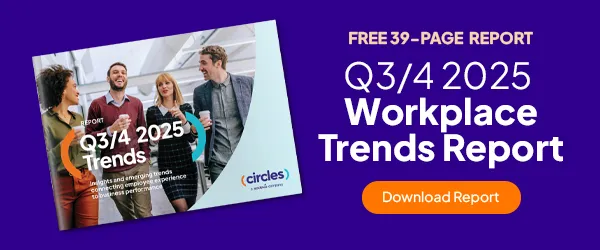Key takeaways from our Q3/4 2025 Workplace Trends Report

Trend 1: Making RTO appealing: reimagine the employee experience
People leaders navigating return-to-office (RTO) strategies are facing a major turning point: employees don’t want mandates — they want meaning. Gen Z and millennial workers, in particular, are vocal about valuing flexibility so much that 40% say they’d trade pay for it. While office visits are up year-over-year in cities like San Francisco and Boston, they're still far below pre-2019 levels, highlighting that physical return is happening — but slowly. To close the gap, employers must shift perspective: the office isn’t just a place to work, it needs to feel like a destination worth the commute.
Leading companies are responding by radically reimagining employee experience. This means not just upgraded spaces, but also thoughtful programming, flexible policies, and emotional resonance. From Marriott’s cozy, connection-focused headquarters to Circles-enabled concierge services and community activations, organizations are designing offices that support well-being, foster belonging, and make everyday work feel a little more human. What’s clear: the future of RTO lies in empathy, not enforcement — and in workplaces that feel less like obligations and more like opportunities.

Trend 2: Addressing generational differences in the workplace
Today’s workplace is more generationally diverse than ever, spanning Boomers to Gen Z. But with that diversity comes a challenge: how do you design experiences, benefits, and communication styles that engage everyone? Engagement is already sliding — global employee engagement dropped to 21% in 2024, the lowest in years. And while U.S. engagement fares slightly better at 31%, it’s still far behind best-practice organizations clocking in at 70%. That gap represents not just a missed opportunity, but a serious business risk.
The organizations getting it right are leaning into generational needs rather than ignoring them. From on-site childcare for working parents to menopause benefits for older employees, personalization is becoming a retention strategy. Engagement looks different for every generation: Boomers value recognition and respect, Gen X thrives on autonomy, Millennials want purpose and feedback, and Gen Z expects tech-enabled, inclusive environments that support mental health. The smartest companies are using tools like flexible benefits, tailored communication styles, and reskilling opportunities to meet people where they are — and keep them invested in where they’re going.

Trend 3: Proving well-being ROI: protecting people and the bottom line
In today’s volatile economic environment — with inflation, tariffs, and borrowing costs on the rise — leaders are being asked to prove the value of every dollar spent. That includes investments in employee well-being. Gone are the days of scattershot perks with fuzzy outcomes. The smartest organizations are making data-backed, strategically targeted well-being investments that directly tie to core business goals like productivity, engagement, and retention. Mental health support, resilience training, and financial wellness programs are taking center stage, not because they sound nice, but because they measurably move the needle.
This shift is more than budget discipline — it’s a new standard for how we support people at work. High-performing companies are embedding well-being into performance and talent strategies, using segmentation to customize services for high-stress teams, and favoring scalable programs with strong perceived value over flashy, high-cost perks. Leaders are also leaning into partnerships with specialized providers to bring expertise and agility without overloading internal resources. The result? A leaner, smarter approach to well-being that supports both people and profit.

Trend 4: Building community becomes a powerful driver of retention
As retention challenges grow more complex, organizations are finding that traditional compensation alone no longer seals the deal. Increasingly, it’s community — not just salary or perks—that drives loyalty. Community gives employees a sense of belonging, connection, and shared purpose. In a hybrid work era where loneliness is quietly rising — especially among remote workers — community-building has shifted from nice-to-have to absolutely essential. Employees who feel connected are more engaged, collaborate better, and are significantly less likely to leave. In fact, SHRM reports that a strong employee experience can make workers 68% less likely to consider quitting.
Leaders are responding with a wide range of creative strategies: evolving ERGs to support broader needs, designing purpose-driven volunteer programs, and embedding structured relationship-building into onboarding and mentorship. Metrics like engagement scores and community participation are now boardroom-level KPIs. And with ideas like “mindful maneuvering”— an intentional, empathetic approach to workplace influence — taking root, it’s clear that culture-shaping is becoming a refined skill. For organizations looking to retain talent and strengthen culture, community isn’t a side project. It’s a strategy.

Trend 5: Shifting employee expectations are changing people management
The employer-employee relationship is undergoing a major reset. Employees today expect more than just a paycheck and perks, they’re seeking purpose, flexibility, personal growth, and support for their whole lives, not just their work output. Flexibility now includes not just where work happens, but when and how. Employees are drawn to roles where they feel aligned with an organization's mission and are increasingly motivated by purpose, well-being, and growth opportunities. For managers, this shift means moving from traditional oversight to a more holistic, human-centered approach.
Organizations are responding by embedding flexibility, personalization, and well-being into the fabric of the employee experience. From asynchronous tools and results-based evaluations to personalized development plans and curated on-site experiences, today’s people management practices are anything but one-size-fits-all. Companies that embrace these shifts are seeing returns not just in engagement and satisfaction, but also in retention and productivity — especially in sectors facing intense competition for talent. In a tight economy, aligning workplace design with modern employee expectations isn’t just thoughtful leadership — it’s smart business.

Trend 6: Using AI tools to improve organizational culture
AI is rapidly transforming the workplace — but its real power isn’t just in automating tasks or analyzing data. It's in shaping how people experience work every day. As organizations continue exploring how AI can improve productivity and streamline operations, a new focus is emerging: using AI to strengthen culture. From understanding employee sentiment to revealing hidden patterns in how teams collaborate, AI tools can offer valuable insights. But they must be implemented thoughtfully — because when used carelessly, they risk eroding trust, amplifying bias, and alienating employees.
Forward-thinking companies are taking a human-first approach. They’re being transparent about how AI is used, training tools to reflect their unique cultural context, and co-designing success metrics with employees. They're also combining AI data with lived experiences to ensure decisions reflect both logic and empathy. The result? More inclusive, trusted systems that support — not replace — human connection at work. When AI is aligned with purpose and people, it becomes a powerful lever for improving both performance and culture.


